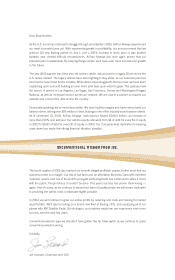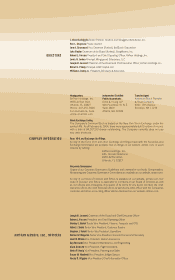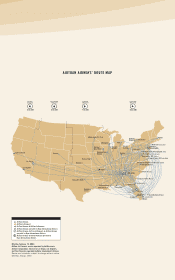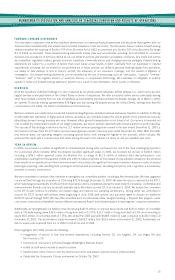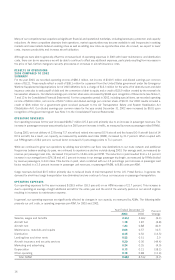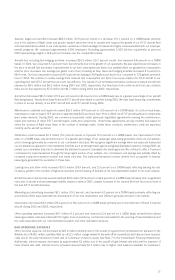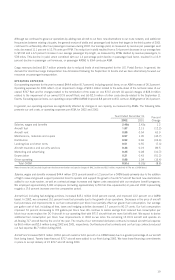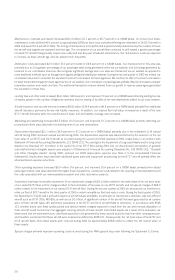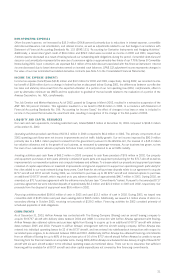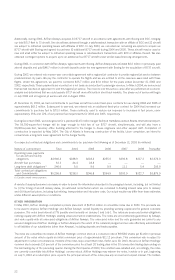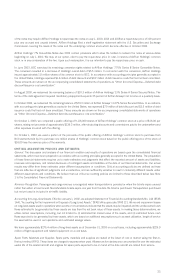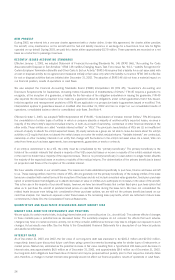Airtran 2003 Annual Report Download - page 17
Download and view the complete annual report
Please find page 17 of the 2003 Airtran annual report below. You can navigate through the pages in the report by either clicking on the pages listed below, or by using the keyword search tool below to find specific information within the annual report.
FORWARD-LOOKING STATEMENTS
The information contained in this section has been derived from our historical financial statements and should be read together with our
historical financial statements and related notes included elsewhere in this document. The discussion below contains forward-looking
statements within the meaning of Section 27A of the Securities Act of 1933, as amended, and Section 21E of the Securities Exchange
Act of 1934, as amended. These forward-looking statements involve risks and uncertainties including, but not limited to: consumer
demand and acceptance of services offered by us, our ability to achieve and maintain acceptable cost levels, fare levels and actions
by competitors, regulatory matters, general economic conditions, commodity prices, and changing business strategies. Forward-looking
statements are subject to a number of factors that could cause actual results to differ materially from our expressed or implied
expectations, including, but not limited to: our performance in future periods, our ability to generate working capital from operations,
our ability to take delivery of and to finance aircraft, the adequacy of our insurance coverage, and the results of litigation or
investigation. Our forward-looking statements can be identified by the use of terminology such as “anticipates,” “expects,” “intends,”
“believes,” “will” or the negative thereof, or variations thereon or comparable terminology. We undertake no obligation to publicly
update or revise any forward-looking statement, whether as a result of new information, future events or otherwise.
OVERVIEW
All of the operations of AirTran Holdings, Inc. are conducted by our wholly-owned subsidiary, AirTran Airways, Inc., which is the second-
largest low-fare scheduled airline in the United States in terms of departures. We offer scheduled airline service principally serving
short-haul markets, primarily from our hub at Hartsfield-Jackson Atlanta International Airport in Atlanta, Georgia. As of March 1, 2004,
we operate 75 aircraft making approximately 436 flights per day serving 45 airports across the United States, serving more than 60
communities in 21 states, the District of Columbia and the Bahamas.
We have created a successful niche in selected markets by targeting price-sensitive business and leisure travelers. In addition to offering
an affordable-fare alternative to higher-priced airlines, we believe we contribute toward the overall growth of the markets we serve by
stimulating demand among travelers who may otherwise utilize ground transportation or not travel at all. Our service is intended not
only to satisfy the transportation needs of our target customers, but also to provide customers with a travel experience worth repeating.
The success of this strategy is evidenced by the 11.7 million revenue passengers we carried in the year ended December 31, 2003, a
20.7 percent increase from the 9.7 million revenue passengers we carried in the prior year ended December 31, 2002. With this traffic
and revenue base, our operating margins, excluding special items, rank among the highest in the domestic airline industry. We
achieved this result with a cost structure that ranks among the best in the industry (in terms of cost per available seat mile).
YEAR IN REVIEW
In 2003, we achieved a number of significant accomplishments during what continues to be one of the most challenging periods in
the commercial airline industry. While the industry recorded significant losses in 2003, we recorded net income of $100.5 million
including a $38.1 million payment under the Wartime Act, a charge of $12.3 million of deferred debt discount/issuance cost
amortization resulting from the paydown of debt and a $15.9 million credit due to the reversal of a tax valuation allowance. We achieved
these results in an operational and financial environment characterized by significant increases in aviation insurance costs, increased
passenger screening costs resulting from evolving security laws and procedures, escalating fuel prices, and, in general, a recessionary
domestic economic environment.
We have undertaken a number of key initiatives to strengthen our competitive position, including a fleet renewal plan. We have upgraded
our aircraft fleet through the acquisition of 73 Boeing B717s through December 31, 2003. We were the launch customer for the B717,
which was designed specifically for efficient short-haul service and is considered among the most modern, innovative, comfortable and
environmentally friendly commercial aircraft available today. We retired our last DC-9 on January 5, 2004. We believe the conversion
to the B717s will continue to enhance our overall image and improve our operating performance. During 2003, we committed to
acquire 50 B737 aircraft with delivery dates beginning in June 2004 with options and purchase rights to acquire an additional
50 B737 aircraft through 2010. We also offer amenities such as a Business Class, assigned seating, a frequent flier program, same
concourse connections at Hartsfield-Jackson Atlanta International Airport and full participation in travel agents’ computer reservations.
Additionally, we strengthened our balance sheet by issuing $145.9 million in common stock equity and $125.0 million of convertible
debt at 7% while paying down $76.5 million of long-term debt at 11.27%, $12.7 million of long-term debt at 13% and converting to
equity $5.5 million of convertible debt at 7.75%. We ended the 2003 year with $348.5 million in cash compared to $138.3 million at
December 31, 2002. Our stockholders’ equity increased to $302.2 million from $51.9 million at December 31, 2002. Additionally, our
debt to equity ratio improved from 4.1 in 2002 to 0.8 at the end of 2003.
Other highlights from 2003 include the following:
•Inauguration of service to four new western destinations, including Denver, CO, Los Angeles, CA, Las Vegas, NV and
San Francisco, CA
•Commenced new service to Ronald Reagan Washington National Airport
•Rolled out self-service kiosks at airport locations
•Implemented online check-in over the Internet and other web-based customer service enhancements
•Celebrated the Company’s 10-year anniversary on October 26, 2003
15
MANAG EME NT’S DIS CUS SIO N AN D ANALYSI S OF F INA NCI AL C OND ITI ON A ND RESULTS O F OP ERATIO NS




